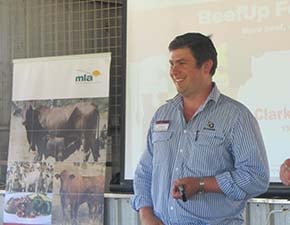How much debt is too much?
 Debt management for rural businesses
Debt management for rural businesses
Borrowing money to grow a rural business is a fact of life, but identifying how much debt an enterprise can support is critical for long-term profitability. Bush Agribusiness director Ian Mclean said understanding the profitability and sustainability of your rural operation helps keep debt at a manageable level and ensures your family can make a viable living. Here, he shares how rural businesses can manage debt.
How much debt can I afford?
Indiscriminate borrowing that is not weighed against the profitability of an enterprise is costly over the lifetime of the debt. Although your bank manager may assist with planning and funding new debt, it pays to remember that the amount a bank is prepared to loan and the debt you can afford can be two different figures.
The level of debt a business can afford depends on:
- the profitability of the business
- the service period of the debt
- the after-debt funds required to run the business and support your family.
Calculating profitability
Business profitability is equal to the operating profit divided by the value of assets used to generate that profit [profitability = profit/assets]. An increase in operating profits increases profitability; however, an increase in assets values (75% of the total assets of most northern beef businesses is land) without corresponding increases in profits, reduces profitability. Therefore, the more profitable the business, the more debt it can afford.
Debt repayment periods are individual to each business; however, certain principals are relevant to all:
- The long-term cost of debt is determined by the length of time the principal is outstanding. If you have a $1 million debt at 6% and repay it over 10 years, 26% of your total repayments will be interest, whereas over 30 years your interest payments will be 54% of total repayments, costing an extra $820,000 in interest alone. In fact, if you borrowed three loans of $1 million over 30 years, repaying each in 10 years, you would pay less interest than on one loan of $1 million over 30 years.
- A productive debt must earn more than it costs to service.
- Capital gains are an important source of wealth creation in the beef industry, however;
- the gains are on paper and don't provide cash that can be used to service debt or provide for family needs unless the land is sold, and,
- they can reduce profitability.
- Producers with debt are not necessarily “better off paying interest than tax”. Paying off debt does come from after tax funds, but you only pay tax on profits once, whereas you pay interest for the lifetime of the debt. If you are not getting a return on capital of more than your cost of debt, you are better off paying down the debt.
- Paying off debt as quickly as possible opens up opportunities. A highly-leveraged operation with long-term debt has limited opportunity for growth. Paying off debt over 10 years allows for making three or more big moves over a 30 year period that result in continued growth of the business.
Breaking down the numbers
Imagine an enterprise with a forecast operating profit of $190,000, which accounts for a wage to the producer, uses long-term cattle prices (refer to budgeting cattle prices),* an interest rate of 7.5% on a debt over 20 years and a tax rate of 30%, and the decision is made to retain 30% of operating profits for family and business needs with the remainder used for servicing debt. This is a low number, and means that more than two-thirds of every dollar of profit goes towards debt, leaving less than a third for provisioning for drought, succession, retirement, funding development, intensification and a margin of safety.
Basing the numbers on paying the debt off over 20 years with a tax rate of 30%, the business can afford to start with debt at 10% of total assets (or equity at 90% of total assets). At this level the owner is paid a reasonable wage, the debt is finalised over 20 years, interest and tax is funded and a small percentage of profit is retained to fund family and business needs. Starting with more debt means the business will not be able to afford this strategy.
This (debt) figure may seem low; however the reality is that agriculture has relatively low average returns from capital. Therefore, it doesn’t take much leverage before all of the returns go into servicing debt. This is a problem for the industry, with the interest paid by the northern beef industry exceeding long-term profits.
Get the EDGE on debt
Understanding the financial performance of your rural business is essential. The skills required are easy to acquire in a BusinessEDGE workshop.
Bush AgriBusiness has scheduled a series of BusinessEDGE workshops, offering a professional development opportunity for rural business owners and managers.
Workshop dates and locations are:
- Brisbane, Queensland 16 and 17 February
- Lake Nash Station, NT 23 and 24 February
- Blackall, Queensland 27 and 28 February
- Georgetown, Queensland 21 and 22 March
- Mackay, Queensland 13 and 14 June
- Darwin, NT 20 and 21 June
Discounts apply to multiple registrations from a single business and early bird registrations (received four weeks prior to the workshop). BusinessEDGE comes with a full money back guarantee.
For more information on BusinessEDGE, or to register go to:
www.babusiness.com.au/thebusinessedge or contact Ian McLean on 0401 118 191.
*This exercise has a long-term (10 years +) perspective, so we use long term prices. Basing long-term debt or property purchase figures using current cattle prices and interest rates is a recipe for disaster.
This article was originally prepared for and published on Beef Central by Ian McLean, consultant and a deliverer of BusinessEDGE workshops.



